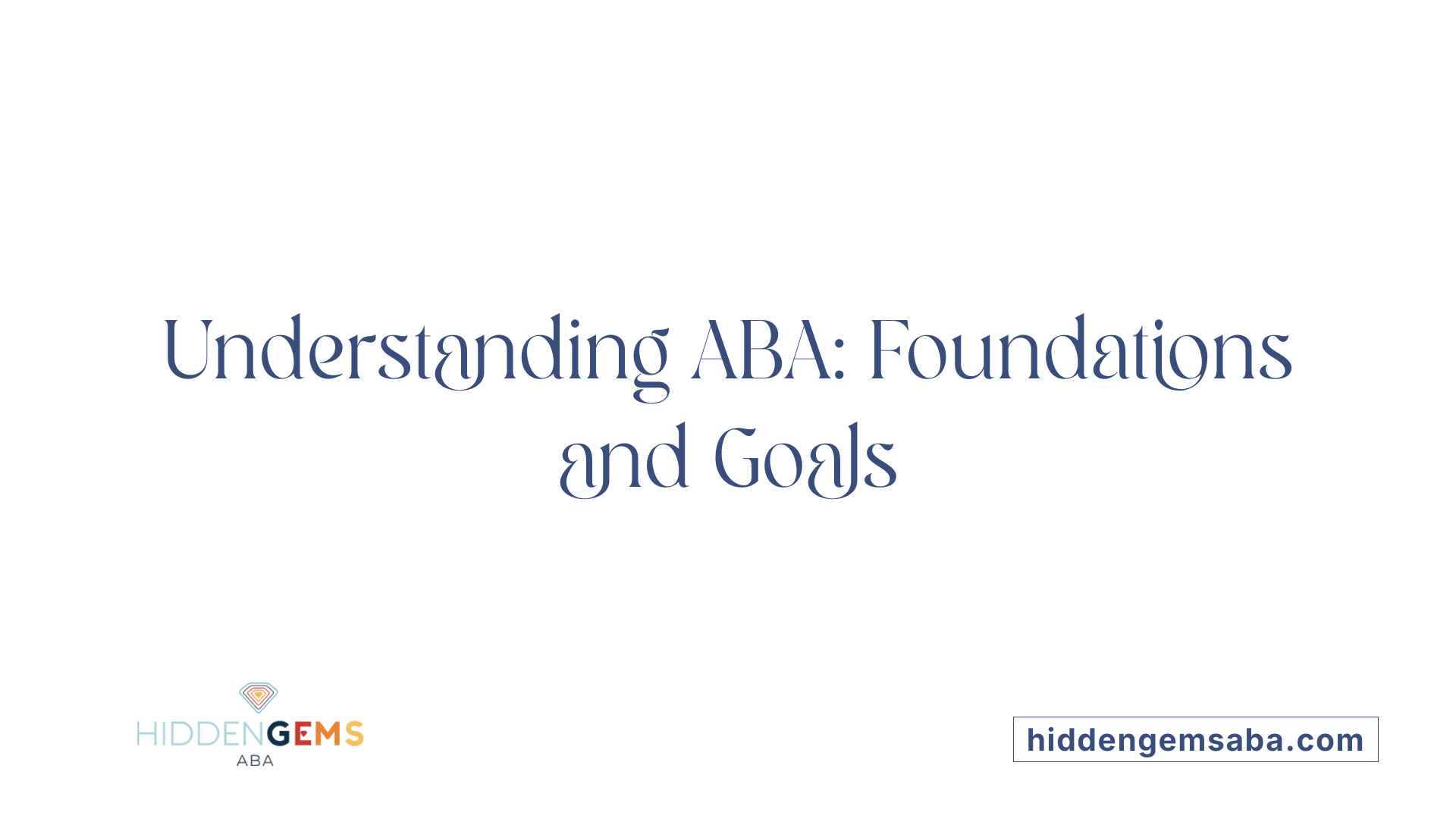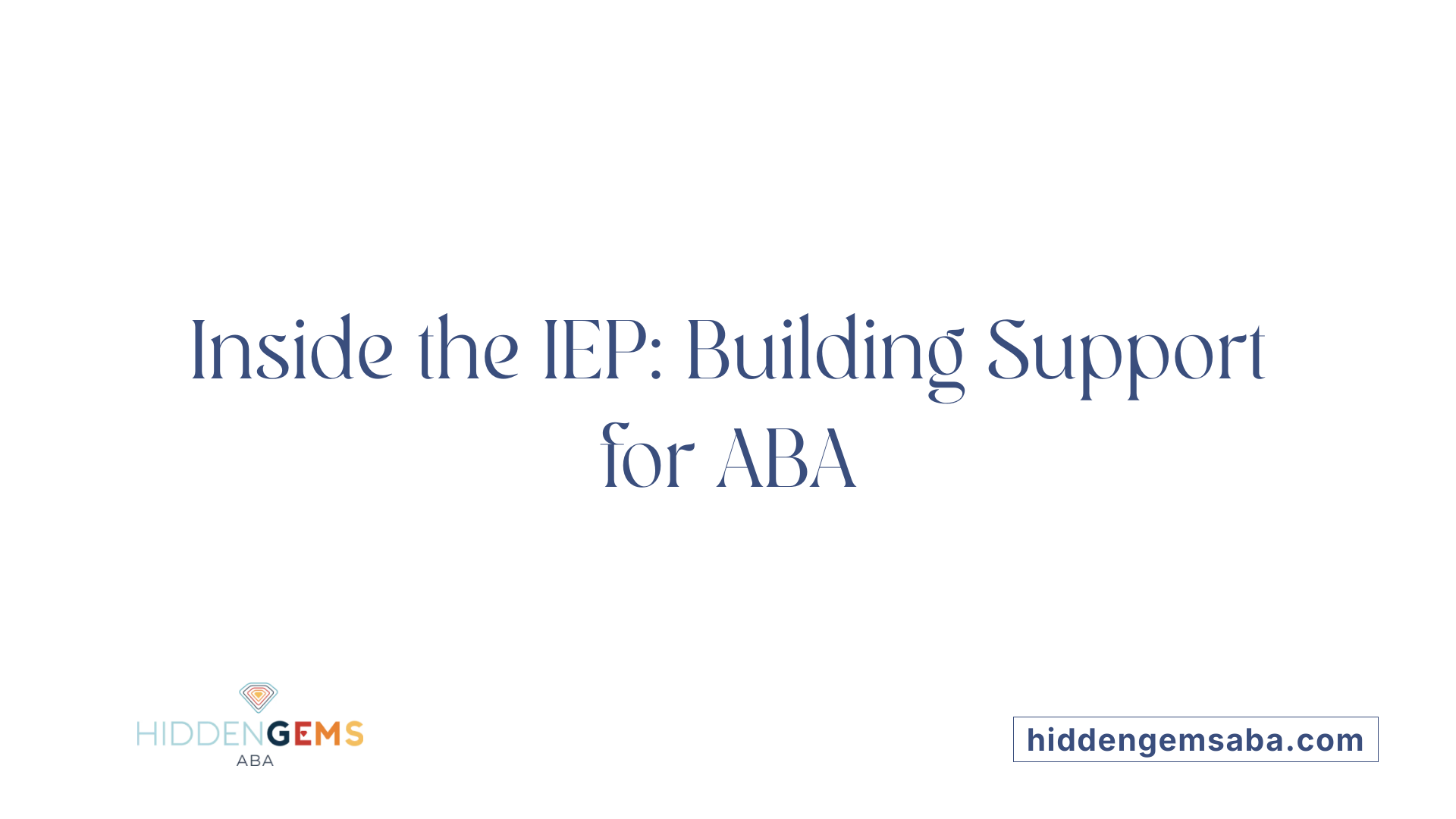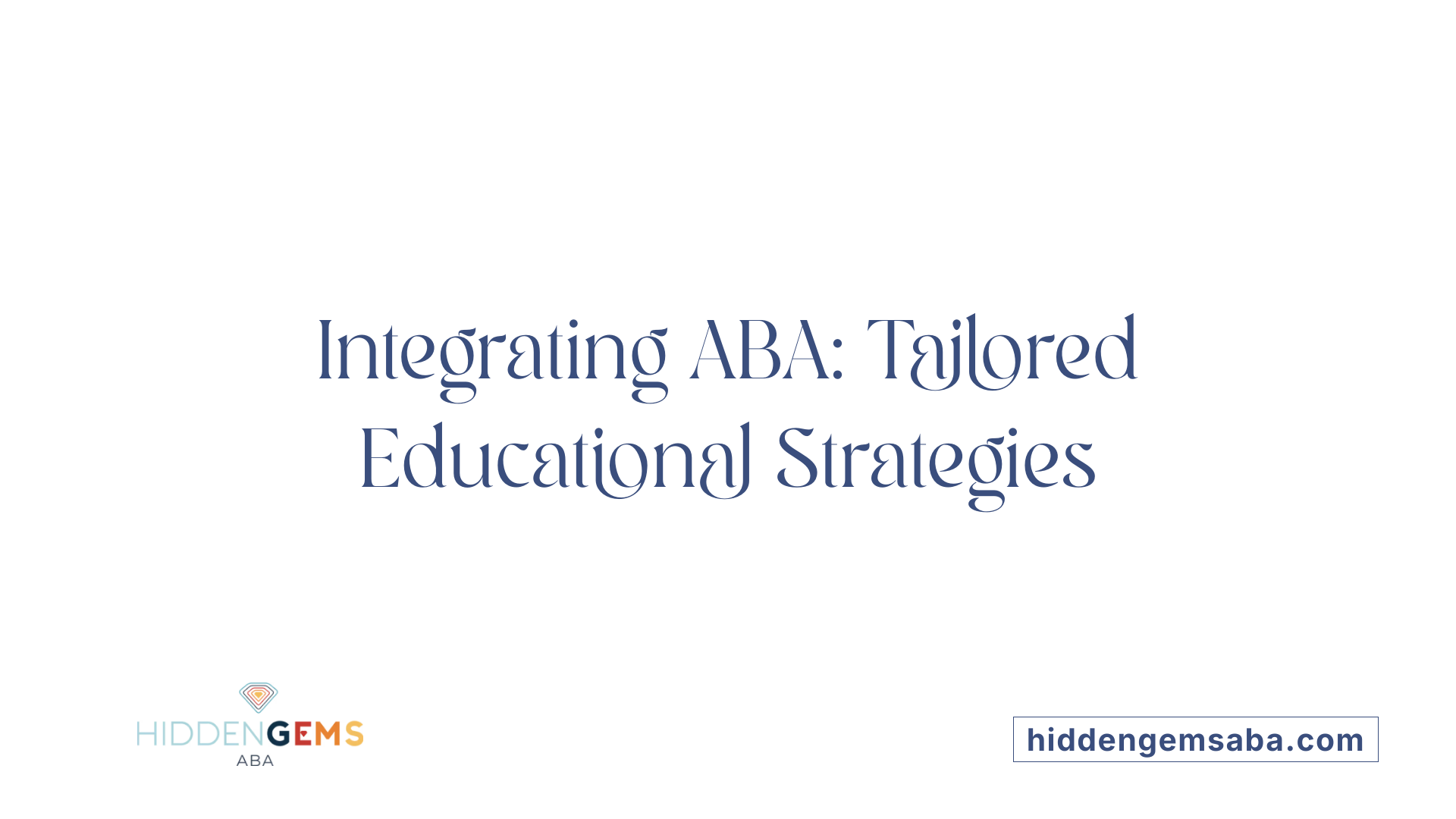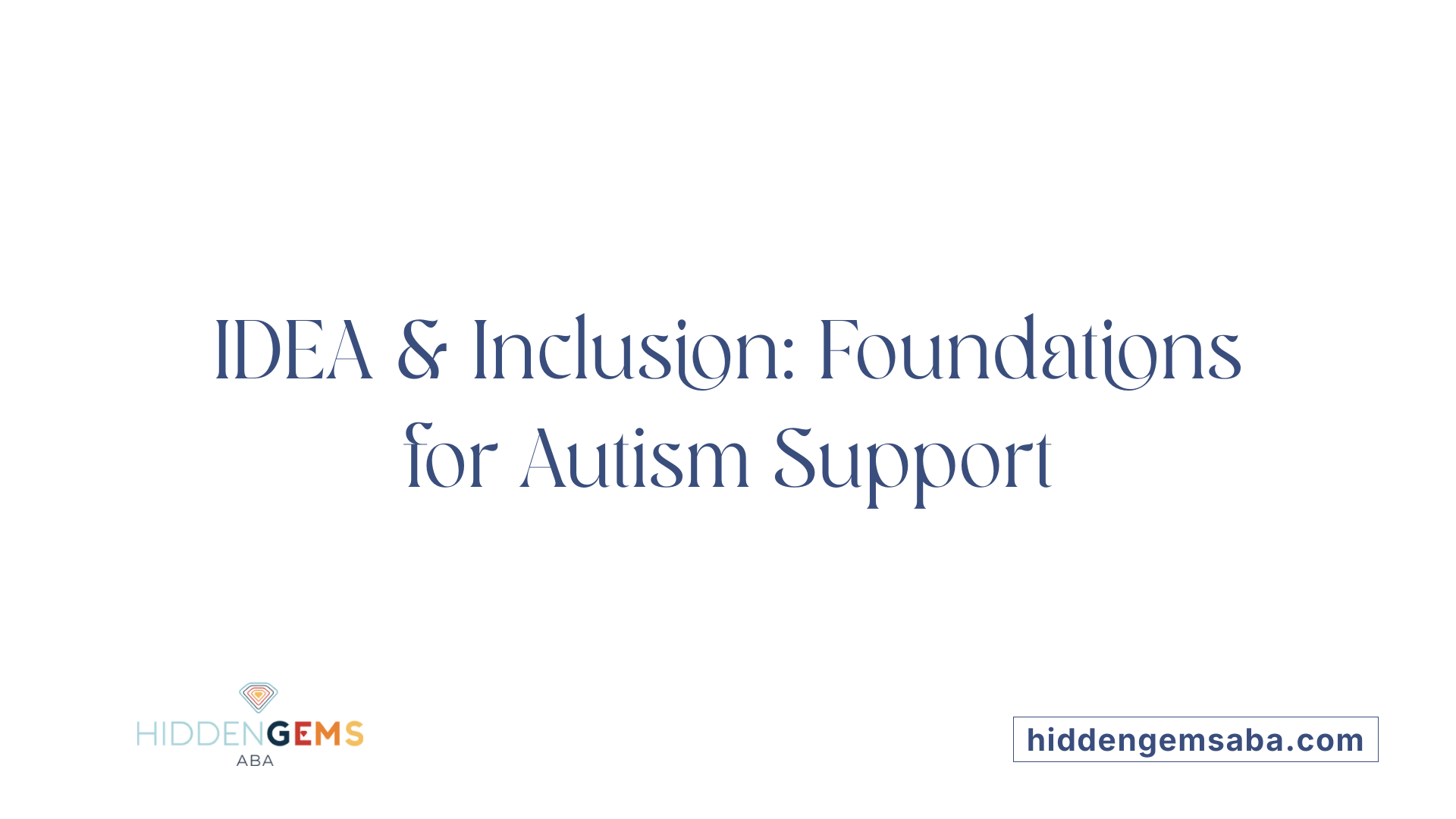Introduction: Framework of Support for Children with Autism
Every child with autism deserves a tailored educational approach that not only recognizes their unique strengths and challenges but also provides appropriate therapy and interventions. ABA therapy plays a pivotal role in these educational plans by bridging behavioral understanding and skill development. This article explores how Applied Behavior Analysis (ABA) therapy integrates within the structure of a child’s Individualized Education Program (IEP) to support learning, growth, and inclusion.
What is ABA Therapy and Its Role in Autism Support?

Definition of ABA therapy
Applied Behavior Analysis (ABA) therapy is a scientifically validated approach that helps individuals with autism develop essential social, communication, and learning skills. It uses principles of behavior to increase positive behaviors and reduce challenging ones through structured and evidence-based techniques.
Primary goals of ABA therapy
The main goals of ABA therapy are to promote independence, improve functional skills, and enhance overall quality of life for individuals with autism. It focuses on fostering skills such as language development and social interactions that are critical for everyday functioning.
Behavioral techniques used in ABA
ABA employs various techniques like positive reinforcement, Discrete-Trial Training (DTT), shaping, and errorless teaching. These methods are tailored to the individual’s needs and promote skill acquisition in an encouraging manner.
Settings where ABA is provided
ABA therapy can be delivered in multiple settings, including homes, schools, and community environments. In public schools, qualified professionals often provide ABA services as part of the Individualized Education Program (IEP), integrating therapy into the educational framework.
Personalization and progress tracking in ABA
Each ABA program is highly customized, with goals designed to match the individual's developmental level and interests. Progress is closely monitored with data collection, enabling therapists to adjust interventions as needed to ensure effective support and growth.
How ABA Therapy is Delivered: Professionals and Providers

Who typically provides ABA therapy services for individuals with autism?
ABA therapy for individuals with autism is primarily delivered by trained and certified professionals skilled in behavior analysis. The central figure in this process is the Board Certified Behavior Analyst (BCBA), who designs and oversees personalized treatment plans after evaluating the unique needs of each child.
Registered Behavior Technicians (RBTs) play a crucial role by carrying out direct therapy sessions with children, implementing the strategies developed by BCBAs under strict supervision. This team-based approach ensures that the therapy is consistent and effective across settings.
These professionals employ evidence-based techniques, such as positive reinforcement and behavior analysis through the Antecedent-Behavior-Consequence (A-B-C) model, to encourage skill development and maintain desired behaviors while reducing challenging ones.
The collaboration among BCBAs, RBTs, and other educational and therapeutic staff forms a comprehensive support network, facilitating the child's progress and integration into educational environments.
The IEP: Structure and Components Supporting ABA Therapy

What is the Purpose of the IEP?
An Individualized Education Program (IEP) is a legally mandated plan focused on addressing the unique educational needs of students with disabilities, including autism. Its main purpose is to ensure that each child receives free and appropriate public education tailored to their abilities and challenges.
What Are the Core Components of an IEP?
The IEP includes various sections designed to provide a comprehensive educational roadmap:
- Present Levels of Academic Achievement and Functional Performance (PLAAFP): Offers a detailed snapshot of the student's current academic skills, functional abilities, strengths, and areas for growth.
- Measurable Annual Goals: These goals are SMART—Specific, Measurable, Achievable, Relevant, and Time-bound—ensuring targeted progress tailored to the student's needs.
- Special Education and Related Services: Specifies therapies and interventions critical for the student’s success.
- Accommodations and Modifications: Adjustments made to instruction or curriculum to support learning.
- Participation in General Education: Details the student's involvement in inclusive, least restrictive environments.
- Assessment and Testing Modifications: Defines how the student will fairly participate in assessments.
- Transition Planning: Prepares students, starting by age 14, for life after school.
- Progress Monitoring and Reporting: Outlines how the student’s progress will be tracked and communicated.
- IEP Team Members and Collaboration: Describes the collaborative team involved.
What Specialized Services and Supports Are Provided?
Within an IEP, related services such as speech-language therapy, occupational therapy, counseling, and specifically Applied Behavior Analysis (ABA) therapy are included. ABA therapy, often supervised by a Board Certified Behavior Analyst (BCBA), is an evidence-based approach widely utilized to support skill development in children with autism.
How Do Accommodations and Modifications Support Education?
Accommodations allow autistic students to access and engage with the standard curriculum without changing its content—for example, providing extra time on tests. Modifications, however, alter curriculum expectations to suit individual abilities. Both are essential to facilitate meaningful participation and learning.
How Does Inclusion Work in the IEP?
The IEP emphasizes participation in general education classrooms whenever appropriate, supporting the principle of the Least Restrictive Environment (LRE). This inclusion fosters social interactions, acceptance, and academic growth alongside non-disabled peers.
Why Is Progress Monitoring and Team Collaboration Important?
Regular progress tracking ensures that goals are being met and helps adjust strategies as needed. Collaboration among parents, educators, therapists, and the student ensures the IEP remains responsive and effective in meeting evolving needs.
| Component | Description | Role in Supporting ABA Therapy |
|---|---|---|
| PLAAFP | Detailed current performance levels | Identifies baseline for ABA goal setting |
| Measurable Goals | Specific objectives to achieve | Aligns ABA objectives with educational milestones |
| Related Services | Therapies like speech and ABA | Provides structured behavioral interventions |
| Accommodations & Modifications | Adjustments to curriculum or delivery | Supports application of ABA strategies in classroom settings |
| Participation in General Education | Involvement in inclusive classrooms | Facilitates social and academic integration |
| Progress Monitoring & Reporting | Systematic tracking and updates | Ensures ABA effectiveness and guides plan revisions |
| Team Collaboration | Multidisciplinary team involvement | Integrates ABA insights into overall educational planning |
Incorporating ABA Therapy into the IEP Framework

Development and Collaboration on IEP Including ABA Goals
An Individualized Education Program (IEP) is developed collaboratively by a multidisciplinary team that includes parents, teachers, therapists, and often a Board Certified Behavior Analyst (BCBA). For children with autism, ABA (Applied Behavior Analysis) therapy goals are integrated into the IEP, ensuring that educational objectives are tailored to individual needs. These goals are SMART (Specific, Measurable, Achievable, Relevant, Time-bound) and built upon assessments of the child's current performance.
Behavior Support Plans and Their Adaptation to School Environments
Behavior support plans, originating from ABA therapy, are carefully adapted to fit the school's educational setting through the IEP process. These plans address behavioral challenges while considering what is feasible and effective within the school environment. The collaborative approach ensures that strategies promoting positive behavior are consistent and sustainable.
Role of Board Certified Behavior Analysts in Schools
BCBAs play a critical role in public schools by developing and overseeing ABA programs, conducting assessments, and training school staff. Their expertise helps align therapeutic methods with educational goals and compliance with IDEA regulations, facilitating a seamless integration of ABA services into a child's educational experience.
Funding and Resource Allocation for ABA within Public School Systems
ABA therapy in schools is typically funded through a combination of public school budgets, private insurance, and Medicaid, depending on state-specific regulations. Resource availability can influence the level of support provided, with some schools offering aides or individual support to augment ABA services.
Therapeutic Methods Used in School ABA Programs
School-based ABA programs employ various evidence-based methods such as peer-mediated instruction, Discrete-Trial Teaching (DTT), shaping, and errorless teaching. These approaches focus on functional and meaningful skill development, promoting academic progress and social integration for students with autism.
Common Goals of ABA Therapy for Students with Autism

What Are the Common Goals of ABA Therapy for Individuals on the Autism Spectrum?
Applied Behavior Analysis (ABA) therapy is designed to support individuals with autism by focusing on several core objectives centered around improving quality of life and functional independence. One primary goal is enhancing communication skills. This involves both expressive abilities (how one expresses needs and thoughts) and receptive skills (understanding what others communicate), which are essential for effective interaction.
ABA therapy also targets the development of social interaction capabilities. Through structured teaching and reinforcement, individuals learn to connect, share, and collaborate with peers and adults, fostering better social acceptance and inclusion.
Another essential focus is the development of daily living and academic skills. This goal equips students with the practical abilities needed to manage everyday tasks and succeed academically, promoting greater independence in school and home environments.
Behavior reduction strategies constitute a critical aspect of ABA therapy. These strategies aim to decrease harmful, unsafe, or disruptive behaviors by utilizing positive reinforcement and customized interventions that teach alternative, more adaptive behaviors.
All these goals are framed within a personalized, functional goal-setting approach, making ABA therapy tailored to the unique needs of each student with autism. This individualized focus ensures that skills taught are meaningful and directly improve the child's ability to function in various settings.
Together, these goals help students build adaptive skills, improve social connections, and foster success both inside and outside the classroom, ultimately enhancing their overall well-being and integration in society.
Measuring the Effectiveness of ABA Therapy within an IEP

How is the effectiveness of ABA therapy typically measured?
Effectiveness is mainly assessed through systematic data collection on specific behaviors targeted during therapy. ABA practitioners utilize behavioral charts and graphs that display progress over time, making it easier to visualize gains in communication, social skills, and reductions in challenging behavior.
Standardized assessment tools, such as the Vineland Adaptive Behavior Scales (Vineland-3) and the Verbal Behavior Milestones Assessment and Placement Program (VB-MAP), play a key role in evaluating broader developmental progress and adaptive functioning. Additionally, tools like the Patient Outcome Planning Calculator (POP-C) help estimate necessary treatment intensity and relate it to measured outcomes.
Regular monitoring and progress updates keep the IEP team informed about the child's development. This ongoing review ensures that therapy remains aligned with set goals and allows for timely modifications based on measurable results.
Parental involvement and transparent sharing of progress data are crucial for maintaining collaboration within the IEP team. Open communication fosters trust and supports informed decision-making about adjustments in the educational and therapeutic plan.
In summary, measuring ABA therapy effectiveness within an IEP involves a combination of systematic data tracking, standardized assessments, continuous monitoring, collaborative adjustments, and transparent communication to ensure the child’s optimal development.
Selecting Quality ABA Providers for Your Child’s IEP
What qualifications should parents or caregivers look for when choosing ABA therapy providers?
When selecting Applied Behavior Analysis (ABA) therapy providers for a child’s Individualized Education Program (IEP), it is essential to look for qualified professionals such as Board Certified Behavior Analysts (BCBAs). These experts ensure that therapy is rooted in evidence-based practices and tailored specifically to the child’s unique needs.
Individualized treatment plans are a cornerstone of quality ABA therapy. Providers should develop comprehensive plans based on thorough assessments, continuously using data-driven approaches to monitor progress and adjust strategies as needed. This ensures interventions are measurable and effective in achieving the child’s goals.
Parental involvement is another critical factor. Providers who actively engage parents in therapy planning and progress discussions foster better outcomes and empower families to support their child’s development beyond therapy sessions. Culturally competent services that respect and incorporate the family’s background and values are equally important.
Quality ABA programs also emphasize supervision and ethical practices. Regular oversight by experienced BCBAs guarantees consistent delivery of therapy, staff training, and adherence to ethical standards.
Parents should feel comfortable observing therapy sessions and asking questions about the provider’s qualifications, treatment methods, data collection, and how progress is communicated. Inquiring about the team’s experience, supervision structure, and strategies for promoting skill generalization helps parents make informed decisions for their child’s educational success.
The Broader Context: IDEA, Inclusion, and Early Intervention

What Does IDEA Require for Students with Autism?
The Individuals with Disabilities Education Act (IDEA) mandates that children with autism receive a Free Appropriate Public Education (FAPE). This education is not just free but customized to meet the unique needs of each student through an Individualized Education Program (IEP). This legal framework ensures tailored support, accommodations, and services that facilitate the student's academic and social development.
Why Is Early Intervention Important?
Early intervention programs are crucial because they begin as soon as signs of autism are identified. These programs focus on enhancing communication, social skills, and academic achievement during the critical early years. Prompt support significantly improves outcomes, helping children develop foundational skills that influence long-term success.
How Does Inclusive Education Work?
Inclusive education integrates children with autism into general classrooms alongside non-disabled peers. Students receive support and accommodations customized to their needs, which fosters not only academic success but also social skills and acceptance by peers. This approach aligns with IDEA's goal of providing a Least Restrictive Environment (LRE) for students.
What Is the Role of Transition Planning?
By age 14, transition planning begins as a formal part of the IEP. This planning prepares students with autism for life beyond school, focusing on employment, further education, and independent living skills. It ensures a thoughtful shift from the school setting to post-school opportunities, supporting lifelong growth.
How Do IEP Team Members Collaborate?
The development and review of an IEP involve a multidisciplinary team. This includes parents, teachers, school administrators, therapists, and sometimes the student, all working together to design effective educational plans. Collaboration ensures comprehensive support across all areas of need, creating a unified approach to the child’s education and therapy.
| Topic | Description | Importance |
|---|---|---|
| IDEA and FAPE | Legal guarantee of free, personalized education for children with autism | Ensures access to education |
| Early Intervention | Early support targeting communication and social skills | Boosts developmental progress |
| Inclusive Education | Integration in general classrooms with supports | Promotes social acceptance |
| Transition Planning | Preparing students for post-school life starting at age 14 | Supports lifelong success |
| IEP Team Collaboration | Parents, educators, therapists jointly creating IEPs | Provides holistic support |
Summary: Maximizing the Impact of ABA Therapy in IEPs
ABA therapy is a foundational element in many Individualized Education Programs designed for children with autism. By understanding its purpose, delivery, goals, and measurement within the IEP framework, educators and parents can collaborate effectively to maximize a child's potential. Qualified professionals, carefully crafted goals, evidence-based practices, and ongoing evaluation ensure that ABA therapy supports meaningful developmental progress. When combined with educational inclusion mandates and early intervention principles outlined in IDEA, ABA therapy fosters both academic success and social integration. The commitment of the IEP team to personalized, coordinated care ultimately helps children with autism thrive in school and beyond.
References
- An Overview of Special Education for Autistic Children
- The Components of an Individualized Education Program
- Does ABA Therapy Replace School? Key Insights
- Expert Columns: Individualized Education Program (IEP)
- Applied Behavior Analysis (ABA)
- ABA Therapy Goals: 25 Practical Examples & Timelines
- Applied Behavior Analysis (ABA)
- Applied Behavioral Analysis (ABA) Therapy
- Applied Behavior Analysis (ABA) for Children With Autism





